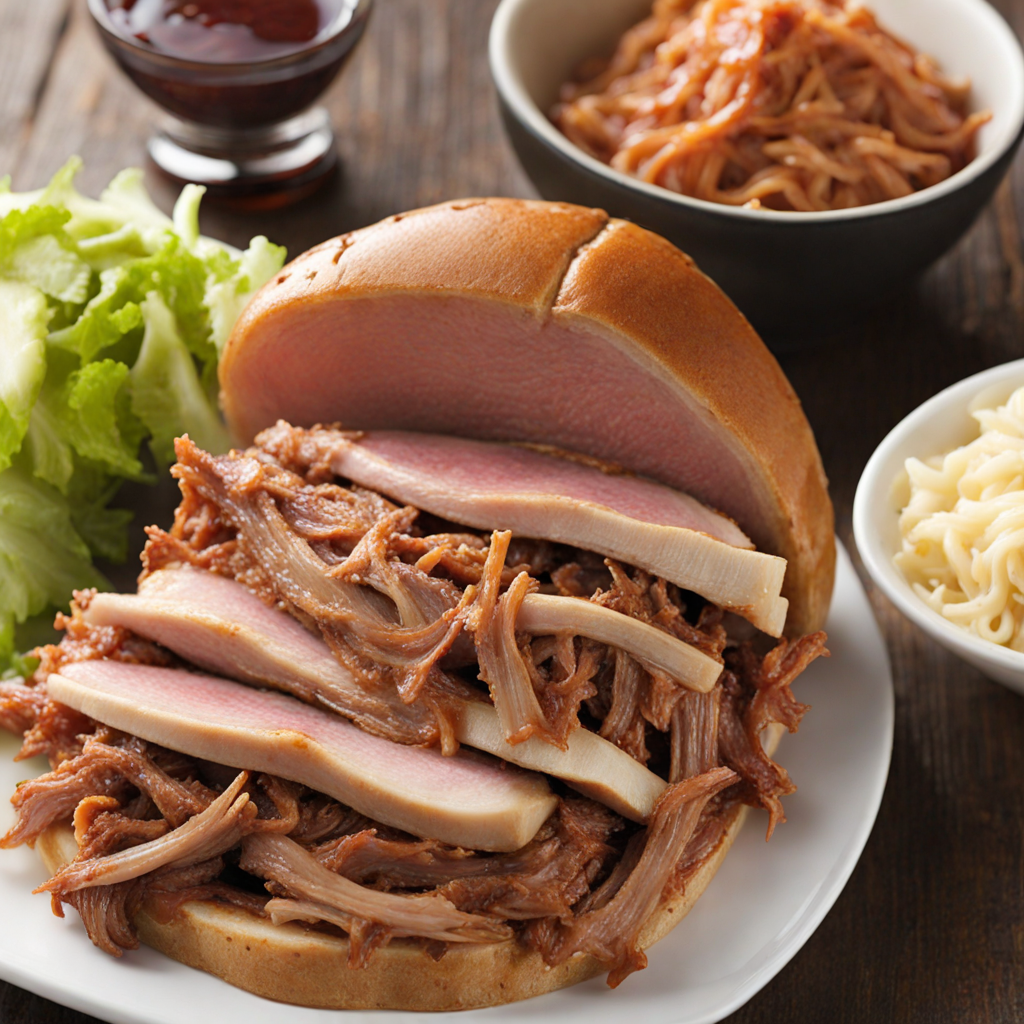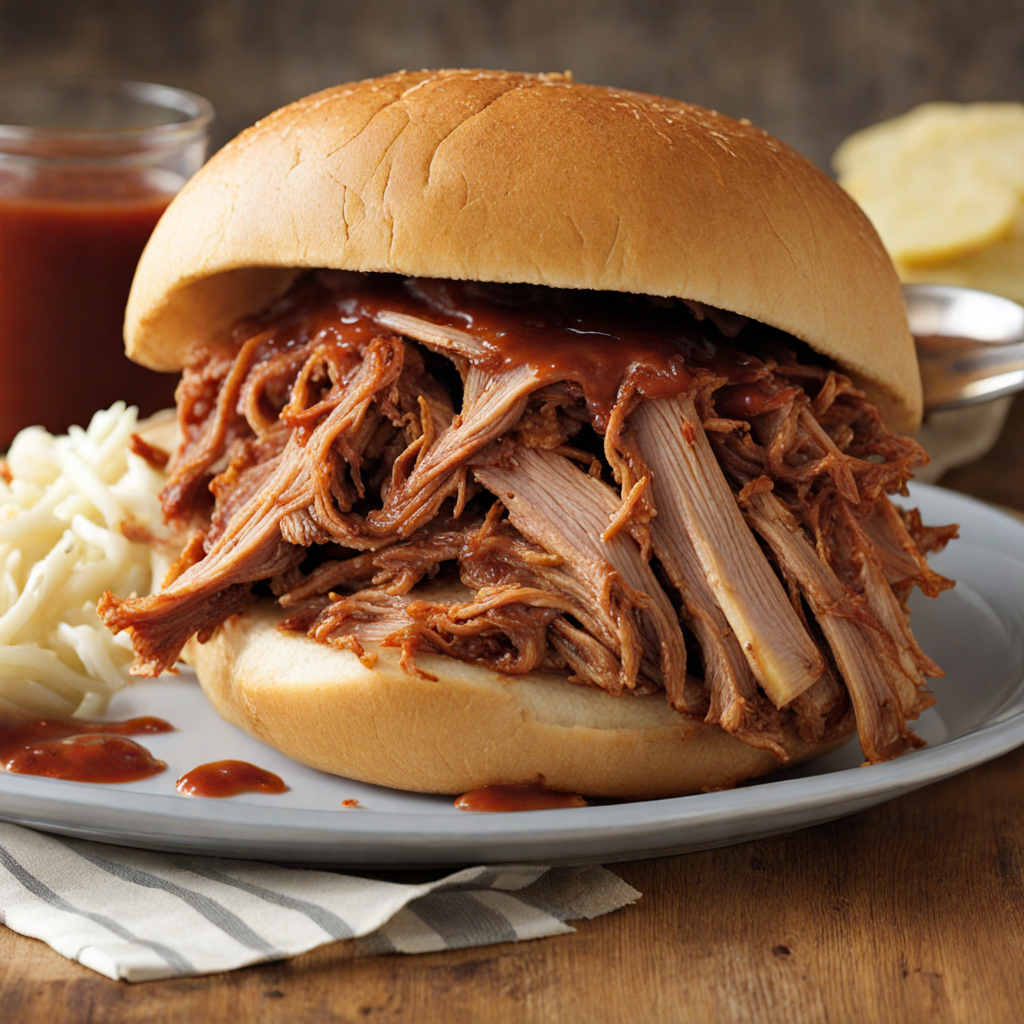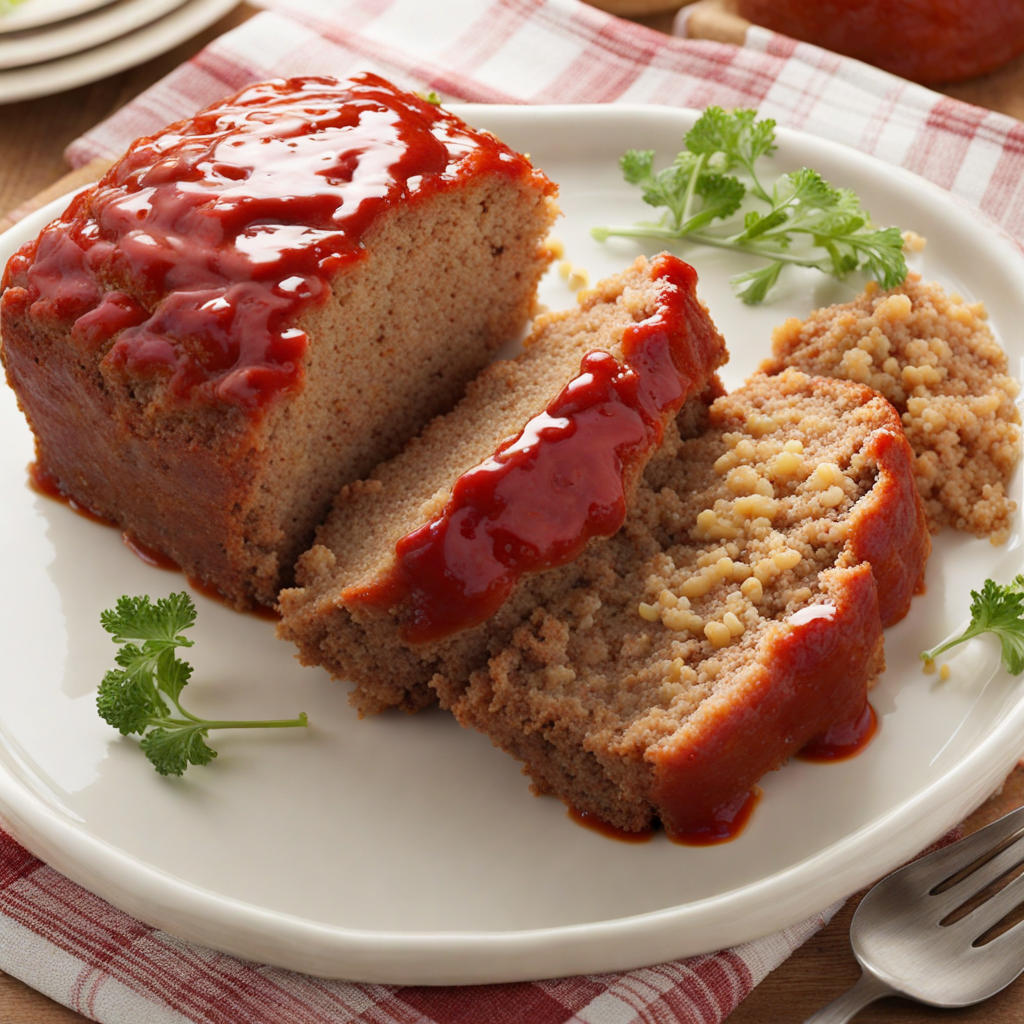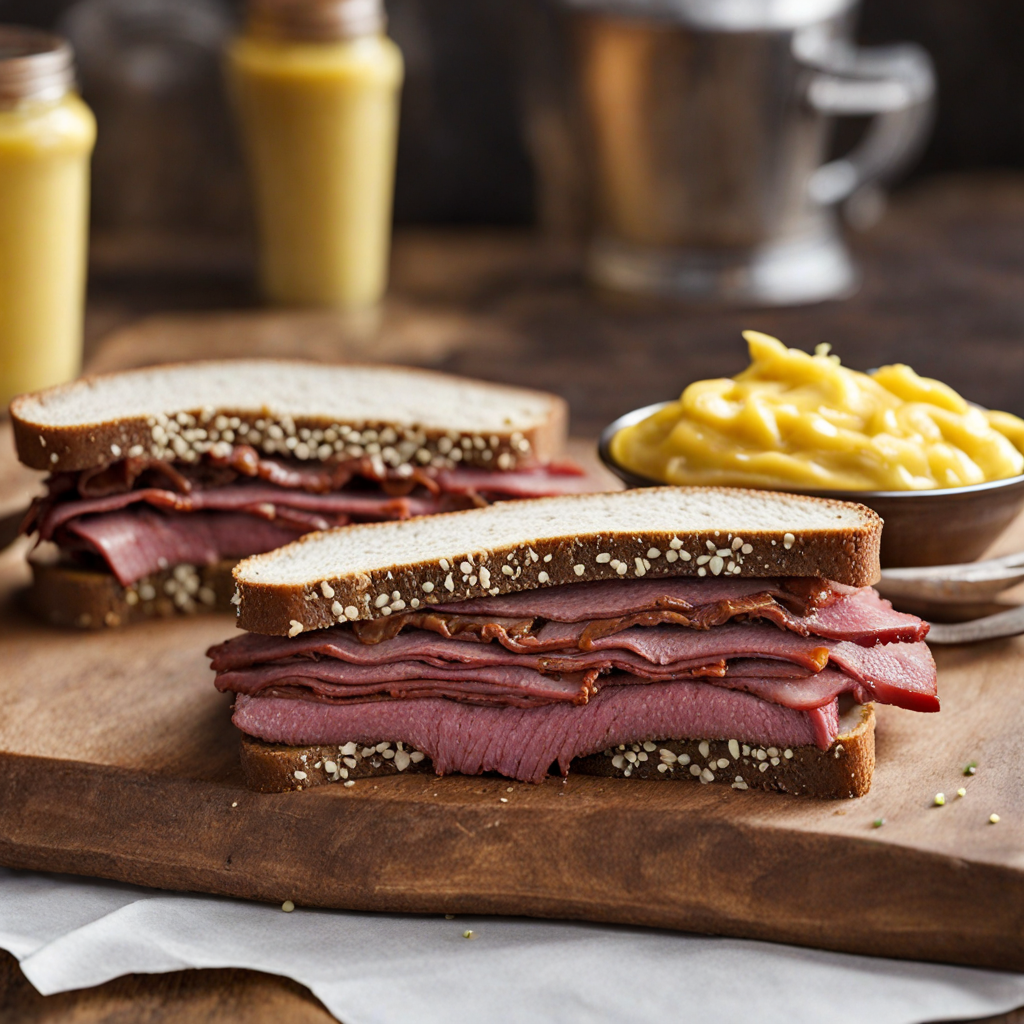Pulled Pork
Pulled pork is a mouthwatering dish that embodies the heart and soul of American barbecue culture, particularly popular in the southern regions of the United States. This dish is made from pork shoulder, also known as Boston butt, which is slow-cooked until it becomes incredibly tender and can be easily shredded with a fork. The cooking process often involves a blend of spices and a smoky flavor, achieved through methods such as smoking or slow-roasting. The texture of pulled pork is succulent, with strands of meat that melt in your mouth, making it a favorite for meat lovers seeking a rich and satisfying experience. The flavor profile of pulled pork is a delightful combination of savory, sweet, and tangy notes. Often marinated or rubbed with a blend of spices that may include paprika, garlic powder, and brown sugar, the pork absorbs these flavors during the long cooking process. Additionally, it is commonly served with barbecue sauce, which can vary from region to region. Some sauces are tomato-based and sweet, while others might be vinegar-based and tangy, adding another layer of complexity to the dish. The balance of these flavors creates a deliciously unique taste that can be adjusted to individual preferences. Pulled pork is versatile and can be enjoyed in various ways. It is frequently served on a bun, creating the perfect sandwich topped with coleslaw for added crunch and freshness. Alternatively, it can be served alongside classic sides like baked beans, cornbread, or mac and cheese, making it a hearty meal. Whether at a backyard barbecue, a food festival, or a family gathering, pulled pork is often the star of the show, inviting everyone to savor its rich flavors and comforting qualities.
How It Became This Dish
The History of Pulled Pork: A Culinary Icon of the United States Pulled pork is more than just a delicious dish; it embodies the rich tapestry of American history, culture, and the deeply-rooted traditions of barbecue. Originating in the southern United States, this succulent dish has evolved through time, influenced by various regional practices, cultural exchanges, and technological advancements. To appreciate pulled pork fully, one must delve into its origins, cultural significance, and the trajectory it has taken through the ages. #### Origins: The Roots of Pulled Pork The practice of slow-cooking and smoking meat has ancient roots, with evidence of such techniques dating back thousands of years. The indigenous peoples of the Americas were among the first to use methods like pit cooking, which involved digging a hole in the ground, lining it with hot stones, and burying meat wrapped in leaves. This method not only preserved the meat but also imparted unique flavors. The specific style of pulled pork that we know today has its roots in the American South, particularly in the Carolinas. Spanish explorers in the early 1500s introduced pigs to the Americas, and over time, these animals became central to the diets of southern communities. The climate of the South—warm and humid—was well-suited for pork production, and by the 18th century, hog farming had become a significant part of rural life. The Southern tradition of barbecue, which encompasses various cooking styles and flavors, emerged during this time. The term "barbecue" itself possibly derives from the Taino word "barbacoa," referring to a method of cooking meat over a fire. In the Carolinas, whole hog barbecue became a communal event, where families and communities gathered to celebrate special occasions with large quantities of smoked meat. #### Cultural Significance: A Symbol of Southern Hospitality Pulled pork is not merely a dish; it is a cultural symbol deeply rooted in Southern hospitality and social gatherings. Historically, barbecue was a communal affair, often tied to significant life events such as weddings, church gatherings, and even political rallies. The act of sharing food brought people together, fostering community bonds and reinforcing social ties. In the Carolinas, pulled pork is particularly significant. The method of cooking the meat involves slow smoking, often over hickory wood, which infuses the pork with a rich, smoky flavor. The pork shoulder, known for its marbling and connective tissue, breaks down beautifully during the long cooking process, resulting in tender, juicy meat that can be easily shredded or "pulled" apart. This practical and flavorful approach to cooking reflects both the resourcefulness of southern cooks and their commitment to using local ingredients. Barbecue festivals have become an integral part of Southern culture, celebrating the craft of barbecue and the communal aspects of enjoying a meal together. Events like the Memphis in May World Championship Barbecue Cooking Contest and the Carolina BBQ Festival draw thousands of visitors each year, showcasing a variety of barbecue styles, sauces, and techniques. #### Development Over Time: From Tradition to Trend As the 19th century progressed, the popularity of pulled pork and barbecue continued to grow, especially in the southern states. The post-Civil War era saw the rise of barbecue as a means of celebrating community and regional identity. In the Carolinas, different styles emerged, with Eastern North Carolina favoring a vinegar-based sauce that complements the meat's natural flavors, while Western North Carolina leaned toward a ketchup-based sauce that added sweetness. The 20th century brought significant changes to the way pulled pork was consumed and appreciated. With the advent of the automobile and the rise of road culture in the 1950s and 1960s, barbecue joints began to pop up along highways, making pulled pork more accessible to a broader audience. These establishments became cultural landmarks, offering drivers a taste of authentic Southern barbecue and contributing to the growing popularity of the dish beyond its regional roots. In recent decades, culinary trends have transformed pulled pork into a national phenomenon. Food networks, cooking shows, and social media platforms have introduced the dish to wider audiences, showcasing its versatility and ease of preparation. Home cooks and professional chefs alike have embraced pulled pork, experimenting with various sauces, cooking methods, and flavor profiles. The rise of food trucks and casual dining establishments has also played a significant role in the evolution of pulled pork. Chefs have reimagined the dish, incorporating global influences and contemporary twists. Pulled pork tacos, sandwiches, and sliders have become staples on menus across the country, reflecting the growing appreciation for fusion cuisine and creative interpretations of traditional dishes. #### The Modern Era: Pulled Pork Today Today, pulled pork is a staple of American cuisine, celebrated for its rich flavors and communal spirit. It remains a beloved dish at barbecues, family gatherings, and sporting events. Moreover, pulled pork has transcended its Southern roots, appearing on menus from coast to coast, and becoming a symbol of comfort food in American culture. The rise of craft barbecue has led to an increased interest in regional variations and cooking techniques. Pitmasters across the country are dedicated to perfecting their craft, utilizing different woods, spices, and cooking methods to create unique pulled pork experiences. Barbecue competitions have also gained popularity, with participants showcasing their skills and creativity, further solidifying pulled pork's status as an iconic dish. In addition to its culinary significance, pulled pork has also found its way into popular culture. References to barbecue and pulled pork can be found in literature, films, and television, often symbolizing comfort, nostalgia, and the warmth of home. The dish represents a connection to the past, a celebration of tradition, and a testament to the enduring power of food to bring people together. #### Conclusion: A Dish with a Story In conclusion, the history of pulled pork is a rich narrative that intertwines food, culture, and community. From its humble beginnings in the kitchens of the American South to its status as a beloved dish across the nation, pulled pork reflects the evolution of American culinary traditions. It embodies the spirit of Southern hospitality, the joy of communal dining, and the creativity of modern cuisine. As this iconic dish continues to evolve, it serves as a delicious reminder of the diverse influences that shape our food culture and the timeless connections forged through shared meals.
You may like
Discover local flavors from United States







